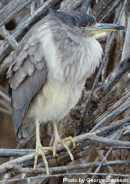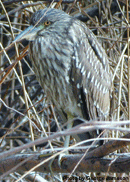|
Nocturnal Birds |
||||||||||||||
|
Our group came together one evening and looked at all the information we had gathered on nocturnal birds in the Poly Canyon area. These are the birds that we found most interesting. We were not able to locate songs for each bird, but as you're reading through, watch for links to hear the melodious calls of the handful that we collected. Enjoy! Common Nighthawk
This bird has moved into towns and cities, where flat roofs provide abundant nest sites, and railroad yards, vacant lots, and sports fields offer good feeding (and breeding) opportunities. Sounds like they would like Cal Poly! Often flying in sunlight, this bird's name is somewhat inappropriate because it is not strictly nocturnal and it is not really a hawk. Yet it does behave like a hawk, catching flying insects on the wing, with a capacity to consume voluminous amounts of insects every day. An analysis of its stomach contents has shown that, in a single day, one bird captured more than 500 mosquitoes and another ate 2,175 flying ants.
Barn Owl
The Barn Owl calls infrequently calls with a drawn-out rasping screech. The courtship call of male at nest is a shrill repetitive twittering. Adults returning to a nest may give a low, frog-like croak. When surprised in its roosting hollow or nest, it makes hissing, rasping, snapping sounds that are often called bill snapping. However, these noises are most likely made by a clicking tongue inside the bill. Barn Owls specialize in hunting small ground mammals, mainly small rodents. Voles, (field mice), are the single most important food in their diet, followed by shrews and rats. Other prey may include baby rabbits, bats, frogs, lizards, birds and insects. Prey are usually located by quartering up and down likely prey containing land - particularly open grassland. They also use low perches such as fence posts to seek quarry. There are plenty of these on Poly Land , especially now that farmers are increasing fencing and incorporating rotation. Barn Owls rely greatly on their silent flight and extremely acute hearing to locate prey. The silent flight prevents prey from hearing its approach and also aids the Owl's hearing. The ear openings are at slightly different levels on the head, and set at different angles. They are covered by a flexible ruff made up of short, densely webbed feathers that frames the face, which serves as a dish-like reflector for sound. This gives the Barn Owl very sensitive directional hearing with which it can locate prey in total darkness. It also allows them to escape detection by humans pretty easily. They may know your location even better than you do! Barn Owls will breed any time during the year, depending on food supply. In a good year, a pair may breed twice. Rodent plagues cause Barn Owl numbers to increase dramatically. The Barn Owl is found in virtually all habitats, but is much more abundant in open woodland, heaths, and moors than forested country. They usually roost by day in tree hollows but have also been found in caves, wells, out-buildings, and thick foliage. The majority of Barn Owls nest in tree hollows up to 20 meters high. Barn Owls don't have a very long life span. Most die in their first year of life, with the average life expectancy being 1 to 2 years in the wild. In North America the oldest known Barn Owl in the wild lived to be 11 years, 6 months. In Holland , a wild barn owl lived to be 17 years, 10 months old.In England , a captive female barn owl was still breeding at 22 years old! The Barn Owl is one of the most wide-spread of all land birds. They are found on every continent (except Antarctica ). They are a remarkable creature. .
Burrow Owl
Adults are a rich sandy-brown color, thickly spotted with whites and buffs on the under parts. This coloring provides good camouflage in dry grassland habitats. Their other features include a rounded head without ear tufts, yellow eyes, white eyebrows, and a white throat with a dark brown half-collar. Juveniles have buff under parts without bars during the first few weeks after emergence from the burrow. Another distinguishing feature of the owl is its tolerance of non-threatening human activity. Nests are sometimes found in cow pastures near farm buildings, on airports, or on road right-of-ways. These tolerances, together with its habit of loafing around on fence posts in daylight, make this one of the most observable of all owl species. This could be a reason why this owl is now on the endangered species list. Although they are easily observed, consider it an honor if you see one! Nests of the Burrowing Owl are usually built in the abandoned burrows of yellow-bellied marmots, belted kingfisher, striped skunks, prairie dog, ground squirrels, badgers, and occasionally foxes. Badger burrows are preferred because of their location in bare, open areas without visual obstructions. Both the sexes prepare the burrow for nesting, using feet, beaks and wings to scrape out dirt. They often begin these renovations at several burrows, eventually selecting the best one as a nest site. This is then often lined with horse or cow dung. It has been speculated that the lining material acts as an absorbent, attracts dung beetles eaten by the owls, masks odors produced by the birds (making detection by predators more difficult), and produces heat by decomposition, which aids in the incubation of eggs. Burrowing Owls are most active at night, but often hunt during daylight--mainly in the early morning and late afternoon. Weasels, skunks, and snakes all prey on the Burrowing Owl's eggs and young. Because Burrowing Owls do not nest in trees, they have many more potential predators. The predators are of two general types: 1) predators that enter or dig up burrows to eat eggs, nestlings, and/or adult females; or 2) predators that prey on older nestlings and adults when they are above-ground.
Great Horned Owl
Great Horned Owls have a large repertoire of sounds, ranging from deep booming hoots to shrill shrieks. The male's resonant territorial call "hoo-hoo hoooooo hoo-hoo" can be heard over several miles during a still night. Both sexes hoot, but males have a lower-pitched voice than females. Great Horned Owls give a growling "krrooo-oo" or screaming note when attacking intruders. Most calling occurs from dusk to about midnight and then again just before dawn. Great Horned Owls hunt by perching on snags and poles while watching for prey, or by gliding slowly above the ground. From high perches they dive down to the ground with wings folded, before snatching prey. Prey are usually killed instantly when grasped by its large talons. A Great Horned Owl may take prey 2 to 3 times heavier than itself. An extremely wide range of prey species (at least 253 identified) are preyed upon by the Great Horn Owl, but rabbits and hares are its preferred prey. A long-lived owl, captive Great Horned Owls have been known to live 29 to 38 years, and wild owls up to 13 years. Most mortality is related to humans - shootings, traps, vehicles on the roads, and electrocutions from fencing. The only natural enemies are other Great Horned Owls and, occasionally, Northern Goshawks (the two birds fight over nest sites). Great Horned Owls have adapted to many different places and climates. They occur in habitats from dense forests, deserts and plains to city parks. They have been known to inhabit the same area as the diurnal red-tailed hawk.
Black-Crowned Night Heron
This bird is a nocturnal and noisy heron. While "day" herons and egrets are roosting during the night, the Black-Crowned Night-Heron is out feeding on fish, frogs, crustaceans, small mammals, and even the young of other colonial-nesting water birds. Their digestive acids are so strong that the bones of their prey simply dissolve in their stomachs. They usually nest colonially among reeds in marshes, or up to 160 feet above the ground in trees. Their nests are seemingly haphazard piles of reeds, sticks or twigs that may, over the years, become very bulky. The Black-crowned Night-Heron lays three to four bluish-green eggs between February and March and again between June and July. Both parents incubate and, after a period of 24 to 26 days per egg, the downy young hatch. Both parents feed the nestlings by regurgitation and six to seven weeks later the young will leave the nest. You might think that a heron, like a flamingo, has its knees on backwards. Well, it doesn't. What you can't see, just under the plumage near its belly, is another joint, folding the way that your knees do. These two joints allow the heron to telescope down over its eggs. In this way, their body heat is evenly distributed across the nest. This heron migrates in large flocks almost exclusively at night, resting during the daylight hours. Their spring migration generally occurs from mid-February through mid-May. Fall migration occurs from mid-July through October. The Black-crowned Night-Heron is widely distributed throughout North America , South America , Eurasia and Africa . They are common winter and breeding residents of much of the Texas Gulf Coast . They also may be found sporadically along the Rio Grande and over northern eastern portions of the state. Although they frequent wooded swamps, ponds, lakes and tropical mangroves, they have also been found to take advantage of other diverse habitats, such as rice fields. They keep close to water and vegetation such as reeds, trees and mangroves where they roost and take cover. Text References
Owl Encounters My father said he liked an owl painting once in my maternal grandmother's home; ever since then, at birthdays and Christmases, he would get an owl gift. He got owl miniatures, owl pictures, a ceramic owl, owl sweatshirts, owl key-chains, an owl spoon, owl towels - you name something that you can put an owl on - he got it. He claimed never to have collected owl things on purpose; the owl things found him. He is an academic and he feels is considered wise partially because he doesn't talk much, and sees why my mom's family, besides picking up on his rare comment about the painting, associates him with owls. Unlike most of my family on my mother's side, he is quiet. He is also a tall man with a beard that covers his expressions. As a child, I wasn't ever sure what he was thinking and was a bit impressed by a majestic quality he had. Owls also seem to have this same quality. Maybe that's why I always want to try and catch a look at them. To see one is like some kind of a smile nature gives you, since these graceful, silent creatures are hidden in darkness and on top of that, they always know where you are since their hearing is so acute. I think I have seen three this quarter, and my first encounter led me to want to create a “Night Life” group. I didn't go out looking for owls at first. I had read that the moon only reflects about six to eleven percent of sunlight and only appears to “shine” because of the dark background of the night sky. I planned to take different pictures of the moon, so I could show it phasing from cloud-like to shiny. My friend and I were doing pretty good hiking at dusk. However, the clouds moved in and my chances to “shoot the moon” were gone. We waited to see if the clouds might pass over, but they didn't. So, when it was just after dusk, we decided to head back. We came to a fork in the trail and opted to go left. I got us lost in the increasingly dark canyon. It was only my second hike in that part of the canyon, and we didn't have the help of the moon. However, once we climbed a peak and started down, we had the aide of the stadium lights, since we were on the other side of Kestrel Crest. (I know my way around now!!) We crossed a grassy field and, were relieved to be able to see again. We stopped for a moment to try and figure out the straightest route back to campus. I happened to turn back to look back the way that we had come, and my friend followed my gaze. He let out a small gasp and pointed up just above where I was looking and there was a huge, hovering night bird. I say night bird, because I am not so sure what it was exactly. At the time, I was SURE it was a bat, despite what everyone said. It was massive and looked gray and moved in jerky arcs just above the grass. I had never seen anything like it. I had seen owls all over my house growing up, and this was not like those things. It wasn't calm, wise, and gentle: it was erratic, powerful, and frightening. Well, maybe what people make of owls aren't really owls at all. Now, after doing a bit of reading and research for this page, I acquiesce, OKAY, it wasn't a bat. It was so huge, my best guess is now an owl, although I have read that owls dive to their prey and this one seemed to be hovering. I make my guess based on size alone. It was a potential owl. It was what inspired me to look closer and to know what to look for, even with the sparse lighting. Just a few weeks later we heard movement from the top of a tree. I looked up and a huge wingspan of a Great Horned Owl hovered over me. I caught my breath. This was even larger than the thing that seemed gray to me over the grass field. The bird appeared black because the light shining behind it. It was gone in a flash, but I got a clear look and can still bring it up in my memory as if it is a photo in my memory. It's not that I have that kind of a mind (I seem to lose my keys every other day), but the silent motion and sheer size of the thing made a stark impression on me. The last encounter I have, I experienced indirectly. I was on an overnight hike with Dr. Marx and Michael, a Poly alum that works for on the Student Experimental Farm. We slept under a massive oak. It was the largest oak I have ever seen in my life. Just before 6, when I woke up, Michael, who knew of my quest to see an owl, told me he has seen one, right before Dr. Marx and I woke up. Dr. Marx thought Michael was making it up. I wasn't sure since I didn't know Michael well enough to know if he was teasing. I can be incredibly gullible. But, sure enough, some bird took a massive shit on my jacket while I was lying under the tree that Michael claimed to have seen the owl in. So, I am pretty sure he was telling the truth. And although Dr. Marx claimed that I should frame it as a commemorative item, I decided that Zout was the better option. I am sure to be spending more nights out in the canyon, with a tape recorder and hopes as high as some of those oaks out there. Maybe I'll be lucky enough to get a really good look at one. It hasn't happened yet, but this story isn't over.
Picture References
Audio References
Home • Wildlife • Domesticated Animals • Plants • Poetry and Stories • About Us • Site Map
|
||||||||||||||

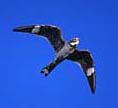 The Common Nighthawk is a jay-sized bird that perfectly matches its environment with its brownish-black feathers on the top and underside of its body. It has a square-tipped tail and long pointed wings with a broad white wing bar. Males and female vary slightly in color. Each has a loud nasal call that can usually be recognized at dusk. They like to live in open woodlands, clearings, or fields; that is, towns with roosting trees or fence posts. We saw one of these birds while on a hike with Professor Francis Villablanca.
The Common Nighthawk is a jay-sized bird that perfectly matches its environment with its brownish-black feathers on the top and underside of its body. It has a square-tipped tail and long pointed wings with a broad white wing bar. Males and female vary slightly in color. Each has a loud nasal call that can usually be recognized at dusk. They like to live in open woodlands, clearings, or fields; that is, towns with roosting trees or fence posts. We saw one of these birds while on a hike with Professor Francis Villablanca.  These pale birds are closely associated with the buildings of humans. Aptly named, these night critters use barn lofts and church steeples as nesting sites. Although widely known beforehand, the Barn Owl was first officially described by Giovanni Scopoli, an Italian naturalist, in 1769. Their upper parts are light gray with numerous fine dark lines and scattered pale spots on the feathers. They have buff markings on their wings and back. Their under parts are white with a few black spots (some have no black spots at all). Feathering on their lower legs may be sparse. The heart-shaped facial disc is white with a brownish edge. They have brown marks at the front of the eyes, which have a black iris. Its beak is off-white and the feet are yellowish-white to brownish. Males and females are similar in size and color while females and juveniles are generally more densely spotted.
These pale birds are closely associated with the buildings of humans. Aptly named, these night critters use barn lofts and church steeples as nesting sites. Although widely known beforehand, the Barn Owl was first officially described by Giovanni Scopoli, an Italian naturalist, in 1769. Their upper parts are light gray with numerous fine dark lines and scattered pale spots on the feathers. They have buff markings on their wings and back. Their under parts are white with a few black spots (some have no black spots at all). Feathering on their lower legs may be sparse. The heart-shaped facial disc is white with a brownish edge. They have brown marks at the front of the eyes, which have a black iris. Its beak is off-white and the feet are yellowish-white to brownish. Males and females are similar in size and color while females and juveniles are generally more densely spotted. 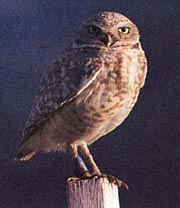 Within the owl family, Burrowing Owls are unusual in many respects: they live in underground burrows in grasslands and not forests, are often active in broad daylight, and they eat insects as well as rodents. Burrowing Owls are ranked by farmers as second only to the Barn Owl as the most economically beneficial owl in North America , since they eat so many insects and rodents near agricultural areas.
Within the owl family, Burrowing Owls are unusual in many respects: they live in underground burrows in grasslands and not forests, are often active in broad daylight, and they eat insects as well as rodents. Burrowing Owls are ranked by farmers as second only to the Barn Owl as the most economically beneficial owl in North America , since they eat so many insects and rodents near agricultural areas.  Great Horned Owls are sometimes known as Hoot Owls, Cat Owls, or a Winged Tiger. Great Horned Owls can vary in color from a reddish-brown to a gray, black, or white. The underside is often a light gray with dark bars and a white band of feathers on the upper breast. Great Horned Owls have large, yellow-orange eyes, which are, for the most part, bordered by an orange-buff facial disc. Their name is derived from tufts of feathers that appear to be "horns" which are sometimes referred to as "ear tufts" but have nothing to do with hearing at all. Like most owls, the key to their acute hearing is the shape of their face, which humans replicate when engineering satellite discs. The sound is focused toward the center in a similar fashion that frequencies of sounds waves are caught by a satellite. Their large feet are feathered to the ends of the toes.
Great Horned Owls are sometimes known as Hoot Owls, Cat Owls, or a Winged Tiger. Great Horned Owls can vary in color from a reddish-brown to a gray, black, or white. The underside is often a light gray with dark bars and a white band of feathers on the upper breast. Great Horned Owls have large, yellow-orange eyes, which are, for the most part, bordered by an orange-buff facial disc. Their name is derived from tufts of feathers that appear to be "horns" which are sometimes referred to as "ear tufts" but have nothing to do with hearing at all. Like most owls, the key to their acute hearing is the shape of their face, which humans replicate when engineering satellite discs. The sound is focused toward the center in a similar fashion that frequencies of sounds waves are caught by a satellite. Their large feet are feathered to the ends of the toes.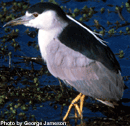 The
Black-crowned Night-Heron is a rather stocky heron. It looks as
if it is hunched over with its head usually tucked down into its
shoulders. Its plumage is gray-white with a distinctive black
cap and a pair of white plumes that extend from the back of the
head. During the breeding season, the black feathers from the
head and back emit a bluish-green gloss and the legs become red.
The
Black-crowned Night-Heron is a rather stocky heron. It looks as
if it is hunched over with its head usually tucked down into its
shoulders. Its plumage is gray-white with a distinctive black
cap and a pair of white plumes that extend from the back of the
head. During the breeding season, the black feathers from the
head and back emit a bluish-green gloss and the legs become red.









